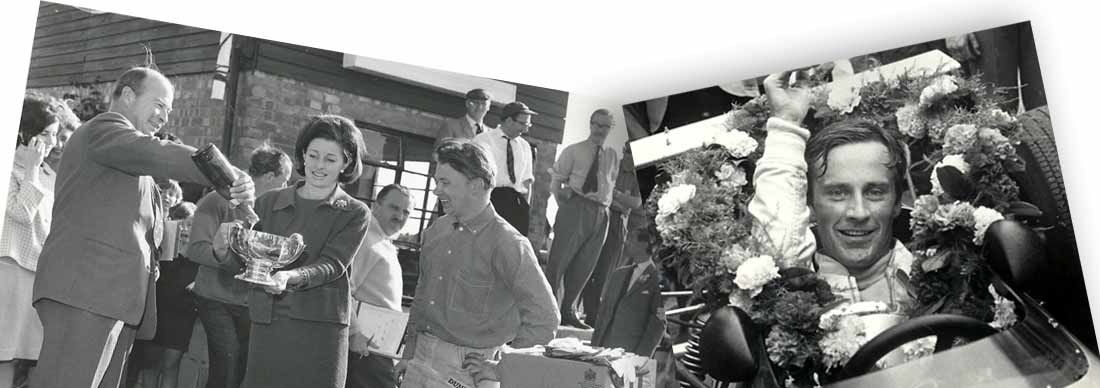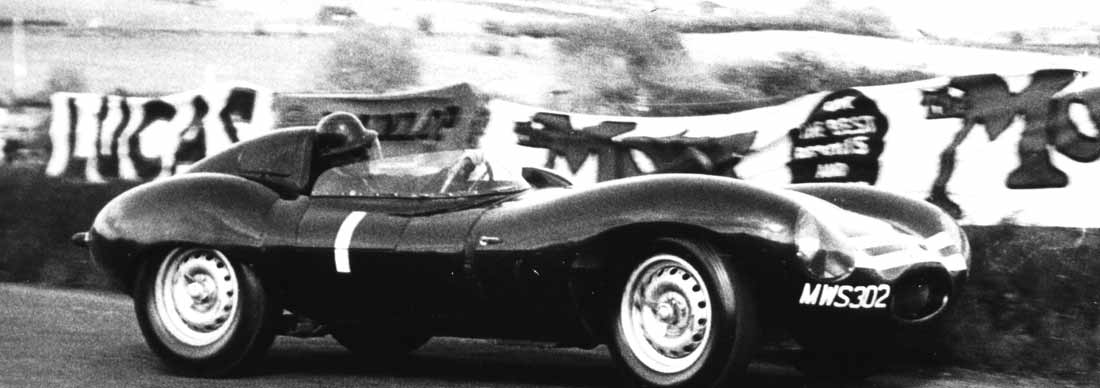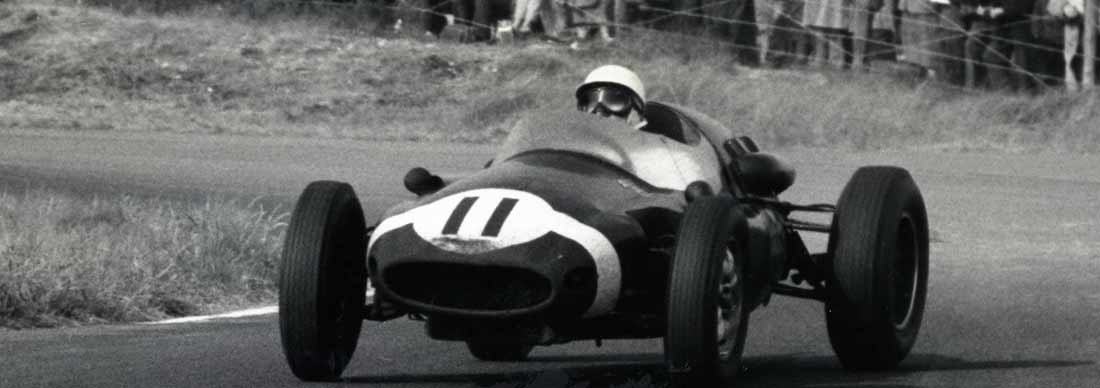
Four Drivers, One School, by Simon Ham
Founded in 1552, Bedford School is one of the UK’s oldest Public Schools, with an illustrious academic, military and sporting history. Its alumni include seven Olympic gold medal winners, 24 rugby internationals, five recipients of the Victoria Cross and a Nobel Prize winner. However, whilst the sporting endeavours of illustrious Old Bedfordians such as Harold Abrahams - winner of the 100 metres at the 1924 Paris Olympics, and subsequently immortalised in the film ‘Chariots of Fire’ - former England Cricket Captain Alastair Cook and former England Rugby Captain and British Lion Budge Rogers are well documented, it is perhaps less well known that the school has also produced a number of leading competitors in an altogether higher-octane sport: motor racing.
A farmer’s son from the small village of Shefford, just outside Bedford, Henry Taylor quickly demonstrated his talents in the competitive world of 500cc Formula Three racing against the likes of Stirling Moss, Peter Collins and a young Bernie Ecclestone. Local connections led to an introduction to Bedford-based Jaguar agents Murkett Brothers, who in 1956 purchased a Jaguar D-type [XKD 517 - TKF 9. Ed] with which to contest national and internationals sports car races. Over the next two seasons, Henry competed in more than 20 events with the car, the undoubted highlight being third place in the 1957 Grand Prix de Spa in which he was beaten only by the two factory-entered Aston Martins of Tony Brooks and Roy Salvadori.
For 1958, Taylor switched to a Lotus 11, in which he finished fourth at Aintree and seventh at Silverstone. Significantly, the latter race would be won by a young Graham Hill, with Henry finishing ahead of big-name drivers such as Innes Ireland - then dovetailing sports cars with his Grand Prix commitments - and double Le Mans 24 Hours winner Ivor Bueb.
Having caught the eye of renowned motor racing talent spotter Reg Parnell, Taylor was offered a return to single seater racing in 1959 with a drive in the British Grand Prix at Aintree. Driving Parnell’s own Cooper T51, he acquitted himself well and finished in 11th place behind the likes of race winner Jack Brabham, Moss and Bruce McLaren.
The following year saw a move to the Yeoman Credit team, and five further Grands Prix - at Zandvoort (Holland), Reims-Gueux (France), Silverstone, Oporto (Portugal) and Riverside (United States). If his 14th-placed finish at Riverside was a disappointment, the dauntingly fast Reims circuit on the closed public roads of Champagne provided the opposite: a hard fought fourth place once again demonstrating genuine pace as well as tremendous bravery. Fittingly, Henry was rewarded with three World Championship points, and a place in a very exclusive club indeed.
Taylor’s move back to a Lotus chassis for 1961 started ignominiously with a failure to qualify for the Monaco Grand Prix, and a bad crash in the British Grand Prix at Aintree in which he demolished an advertising hoarding and broke several ribs. His return to Reims yielded only a 10th placed finish this time, whilst 11th in the Italian Grand Prix at Monza would prove to be his Formula One swansong, the effects of his lingering injuries from Aintree causing him to question the wisdom of a future in single seaters.
Having taken a racing sabbatical in 1962, Taylor became heavily involved with the development of the new Ford Cortina, forging a top line career in Touring Car racing and rallying for the next three years. Results, including second place in the Brands Hatch 6 Hours and third in the Nurburgring 6 Hours, further cemented his ties with the Blue Oval, eventually leading to his appointment as Ford’s Competition Manager in 1965.
Henry later settled in the South of France where he founded a successful yacht sales business, becoming a Director of the British Racing Drivers’ Club in 1992. After eight years’ loyal service on the board of the BRDC - during which he commuted from the Cote d’Azur for monthly board meetings - he was made a Vice-President of the Club in 2000. He died on 24 October 2013, aged 80.
Mike Beuttler, born in Cairo, on leaving Bedford found gainful employment with renowned racing car dealers and successful racing team The Chequered Flag, of Chiswick. After an abortive first attempt at racing, Beuttler returned to the sport in 1968 at the wheel of a year-old Brabham Formula Three car. With backing courtesy of stockbroker friends Ralph Clarke and David Mordaunt, he embarked on a mammoth season which saw him participate in no less than 54 races with the trusty little car, whilst 1970 saw him come of age as a driver with a win in the Formula Three race supporting the British Grand Prix at Brands Hatch.

For 1971, Beuttler’s generous backing - now augmented by another stockbroker, Alastair Guthrie - ensured that he competed in both the highly competitive European Formula Two Championship, as well as enjoying selected outings in the rarefied world of Formula One. In Formula Two - racing against the likes of Graham Hill, Niki Lauda and John Watson - Beuttler enjoyed a solid year, taking a well-deserved win in the final round of the Championship at Vallelunga, near Rome. Unsurprisingly, Formula One would prove a somewhat tougher nut to crack, his first Grand Prix - appropriately the British, at Silverstone - ending in retirement, and the remaining four rounds in which he competed that year all ending in either retirement or non-classification.
Having purchased a new March 721G for the 1972 season, Beuttler embarked upon an ambitious season which saw him participate in every European and North American round of the Formula One World Championship. After failing to qualify in Spain, he took a distant 13th place at Monaco, a result repeated three races later at Brands Hatch. The highpoint of his year was a valiant eighth place in the German GP, held at the notorious 14-mile Nurburgring circuit in the Eifel Mountains, whilst the Italian GP at Monza saw him finish 10th - just one position behind the works-entered March of highly rated ‘Super Swede’ Ronnie Peterson.
The 1973 World Championship season would be Beuttler’s last. Continuing with the privateer focussed - if recalcitrant - March chassis entered by the now bewilderingly named Clarke-Mordaunt-Guthrie-Durlacher Racing Team, he would contest every round of the championship except the French Grand Prix. In the Spanish Grand Prix, held at the notoriously unforgiving Montjuic Park circuit in Barcelona, he achieved the best result of his career by finishing seventh immediately behind former World Champion Denny Hulme, whilst at Anderstorp in Sweden two months later he finished eighth. Ultimately, however, the season proved a frustrating one, with retirements in Brazil, Monaco, Holland, Austria, Italy and Canada.
The final round of the championship, the US Grand Prix at Watkins Glen in upstate New York, proved to be a traumatic one. The charismatic and popular Frenchman Francois Cevert had perished in an horrific practice crash, his team-mate Jackie Stewart retiring from the sport on the spot. Visibly shaken by the loss of his old Formula Two sparring partner, Beuttler drove a low-key race to finish 10th, subsequently opting to join the World Champion in retirement. Although he had failed to score a World Championship point in any of the 28 Grands Prix which he started, he had earned a justified reputation as a capable and determined privateer, frequently handicapped by uncompetitive equipment.
A one-off drive in a March sports car in the 1974 Brands Hatch 1000 kilometres aside, Beuttler walked away from motor racing entirely, moving initially to San Francisco before settling in Malibu. As Formula One’s first - and thus far, only - openly gay driver, he reasoned that 1970s California afforded him greater sexual freedom than did contemporary Europe. Tragically, he died from an AIDS-related illness in Los Angeles in 1988, aged just 48.

One of Beuttler’s contemporaries, David Ham was also a successful semi-professional driver in the 1960s, prior to a later career in the burgeoning world of historic racing. A chance trip the 1959 Daily Express International Trophy at Silverstone - a non-World Championship Grand Prix in all but name - at the suggestion of friend John Waters had aroused his interest in the sport, and by 1960 he had purchased a venerable pre-war Singer Le Mans with which to compete in British club racing events. In 1961, Ham progressed to the ex-London Motor Show Aston Martin DB3S, a car which afforded him the chance to experience, in his words, ‘A proper racing car’ for the first time.
For the 1962 season, the DB3S was replaced by the ex-works Aston Martin DBR1 which had been driven to victory by Roy Salvadori and Carroll Shelby in the Le Mans 24 Hours race only three years earlier. Although the opposition he faced was increasingly of the faster rear-engined variety, the front-engined DBR1 remained competitive, with victory ahead of former US Grand Prix winner Innes Ireland (in his rear-engined Lotus 19) at Snetterton in July 1963 being one of which David was justifiably proud. With the likes of old Etonian Piers Courage - heir to the Courage brewing fortune, and future Formula One driver for the then little-known Frank Williams - on the grid alongside him, Ham forged a justified reputation as a highly capable sports car driver throughout the 1960s.
With the temperamental DBR1 making way in 1966 for a lightweight Lotus Elan 26R, 1969 saw a return to ‘big banger’ sports cars with the purchase of the Lister-Jaguar formerly owned by Scottish industrialist Sir Alexander Miller. It was with the Lister that David became synonymous, the pairing taking part in over 300 races over the ensuing four decades and enjoying many victories in the FIA Historic, Lloyds & Scottish Historic and V12 Endurance Championships. If 1976 proved to be an itinerant year - with victories at Croix-en-Ternois, Le Mans, Nurburgring, Nivelles and Zolder - it was also a fruitful one, with the coveted ‘Jaguar Driver of the Year’ award and membership of the British Racing Drivers’ Club following the next year.
Unashamedly a sports car devotee, David enjoyed periodic forays into single seater racing, having both owned and competed with the ex-Stirling Moss 1952 HWM Formula 2 car, the unique 1959 JBW Formula 1 car and the ex-Rupert Keegan/Davina Galica 1977 Hesketh 308E Formula 1 car. Later, Ham also competed further afield, enjoying further success in South Africa with his Lotus 23B and friend Chris Wilson’s McLaren M1B, and in both Australia and New Zealand with the faithful Lister.
However, it is entirely appropriate that his final race in 2010 - some 50 years after his first - was at the wheel of his Jaguar E-type, co-driven by son Simon. He passed away in 2016 after a short illness, although the Lister-Jaguar and David’s other cars are retained by his family and still continue to be raced and enjoyed to this day.

With his Hollywood good looks, easy-going charm and seemingly boundless self-belief, Dan Wheldon appeared to many the quintessential racing driver. Already a three-time British karting champion by the time he was 13, in 1996 he made the transition to cars, finishing second in the British Formula Vauxhall Junior Championship. In 1999, Wheldon moved to the US to further his career, winning the 1999 US Formula Ford 2000 Championship in his first year.
Having finished runner up in the 2000 Toyota Formula Atlantic and 2001 Indy Lights Championships respectively, he set his sights on a drive in the top-line IndyCar Series - something which he achieved for the final two rounds of the 2002 season with the Panther Racing squad.
With Panther lacking the necessary funding to run Wheldon for 2003, he entered talks with the crack Andretti-Green team and was initially recruited as a replacement for their injured lead driver Dario Franchitti. Quickly displaying an affinity for oval circuits so often lacking amongst European drivers, Dan was rewarded by an 11th-placed finish in the Championship and the coveted IndyCar Series ‘Rookie of the Year’ award.
In 2004, he remained with Andretti-Green and his remarkable consistency - which included three wins and eight third places - saw him take the Championship runner’s up spot. However, it was 2005 which would prove to be the summit of Dan’s career - six wins securing him a maiden IndyCar Championship, as well as victory in the blue riband Indianapolis 500-mile race, in doing so becoming the first Briton to win the race since Graham Hill in 1966.
A lucrative move to Andretti-Green’s fierce rivals Chip Ganassi Racing for the 2006 season yielded a further two race wins and five other podium finishes, the title only being lost on race win countback following a tie with eventual Champion Sam Hornish Jr. The season’s other highlight was an unexpected victory in the around-the-clock Daytona 24 Hours endurance race with Ganassi team-mates Casey Mears and Scott Dixon, a result which led to him being awarded a coveted BRDC Gold Star award at the end of the year, ahead of the likes of Jenson Button, Mark Webber and David Coulthard.
Having opted to leave Ganassi after fourth-placed championship finishes in both 2007 and 2008, Wheldon returned to former team Panther Racing for the next two seasons. A further two excellent showings at Indy aside - in which he finished second on both occasions - the end of the decade would prove to be a tough time for the personable Brit.
Without a regular seat for 2011, Wheldon took a one-off drive with the unfashionable Bryan Herta Autosport team for his beloved Indy 500 and in one of the biggest upsets in Indy history, promptly won the race for a second time. Remarkably he only took the lead on the final lap, in so doing breaking a record for the fewest laps led in a 500 victory which stretched back to 1912. Having secured a deal for the last two races of the season at the Sam Schmidt Motorsports team, Wheldon finished 14th at the Kentucky Indy 300 before preparing for the final round of the year at the fearsomely fast Las Vegas Motor Speedway, where average lap speeds approached 225mph.
Before the race, the IndyCar organisation had offered a $5 million purse to any driver managing to win the race by starting from the back of the grid. Never one to pass up a challenge, Wheldon made a strong start and had moved up to 24th place by lap 11. However, three cars touched in front of him and - according to his car’s telemetry, at approaching 224 mph - even the reactions of ‘Lionheart’, as the American racing press had fondly dubbed him, could not prevent his car from being launched into the air with predictably catastrophic consequences. In all, some 15 cars were involved, and tragically Dan suffered severe head injuries to which he would succumb later that afternoon. Aged just 33, he left behind his wife of three years, Susie, and their two infant boys Sebastian and Oliver.
With 16 IndyCar wins from 132 starts, two Indianapolis 500 victories and a Daytona 24 Hours crown, Wheldon had been one of US racing’s brightest lights for over a decade and his loss there, and to motorsport as a whole, was immeasurable. That the IndyCar fraternity abandoned the race immediately after his accident, yet reassembled the surviving cars later that afternoon to run an emotional - and unprecedented - three-wide, five lap formation salute in his honour said everything as to the esteem in which he was held.
Whether the successes of these illustrious Old Bedfordians are attributable to the cultivation of a strong competitive spirit at school, a quirk of geography - with Bedford being close to the UK’s “Motorsport Valley” - or are mere coincidence, that all went on to achieve so much is something of which the school can be justifiably proud. All were very different, yet with much in common: each had the same steely determination to triumph against adversity, and all gained the respect of their peers - both on and off the track. Perhaps the way in which they all conducted themselves can, ironically, be best summed up by a famous Old Haileyburian, Stirling Moss: ‘It’s not how much you win, boy - it’s the way you do it’.
Books by Simon Ham






Leave a comment
This site is protected by hCaptcha and the hCaptcha Privacy Policy and Terms of Service apply.